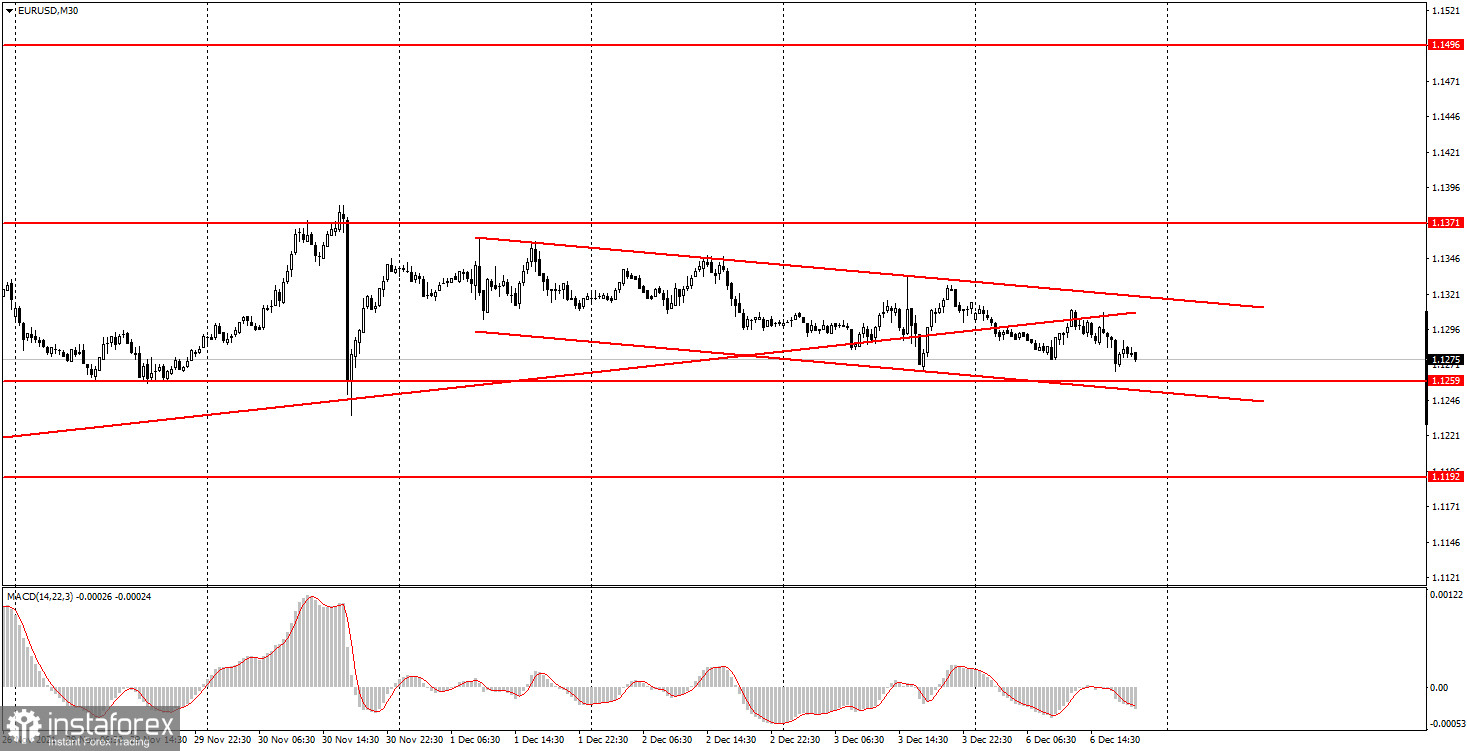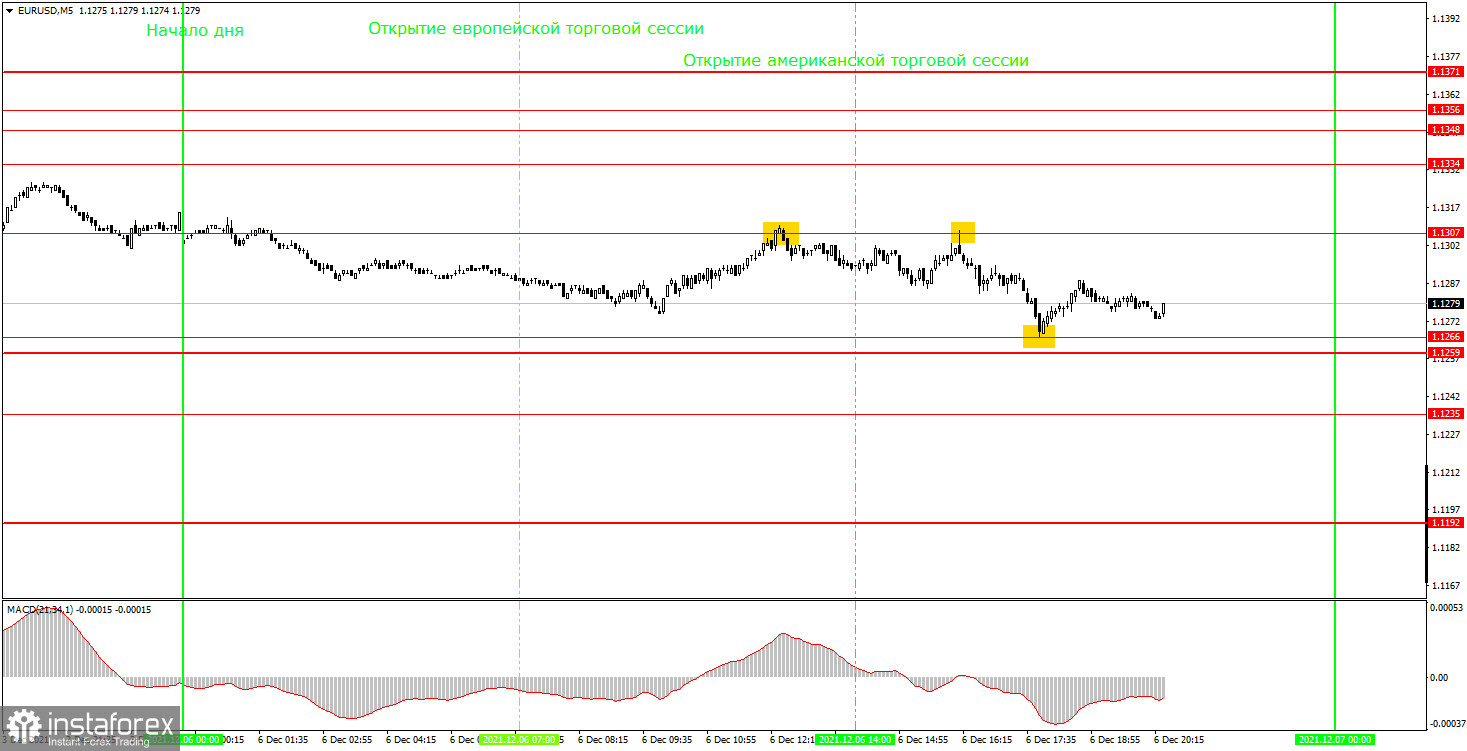Analyzing trades on Monday
EUR/USD on 30M

The EUR/USD pair was moving in a rather narrow range on Monday. As we can see in the picture below, the uptrend line is no longer relevant, since the price has settled below it. To be more precise, the price simply stopped noticing it. On the other hand, a new downward channel formed immediately and it is very similar to a sideways channel, which is also clearly seen in the picture. In addition, the channel is quite narrow, with the range of only 65 pips, and the pair has been holding in it for 4 days already. Thus, it is difficult to count on a strong trend now. Moreover, neither the European Union nor the United States had a single important report or other events on Monday. Even on Friday, when a bunch of important statistics was published in the US, the price movement was much weaker than we would expect. Thus, the US dollar is currently rising but only technically. We are waiting for the price to leave the channel so that a new movement could start, and we hope that it will be stronger than the current one.
EUR/USD on 5M

On the 5-minute time frame, the picture on Monday was very favorable for novice traders. Only three trading signals were generated and they all were accurate and clear. Let's discuss them and see how you should have traded on Monday. The first signal was formed upon a rebound from the level of 1.1307 and was repeated a few hours later as the price returned to this level and rebounded again. After the formation of the first signal, the price went down by only 13 points, so we did not set the Stop Loss order to a breakeven point. Accordingly, when the second signal was formed, novice traders had to stay in their short positions. After that, the price dropped to the nearest support level of 1.1266, which is Friday's low, and bounced off it. Thus, we managed to earn about 25 pips on a sell trade. A buy position should not have been opened on the last signal since it was formed too late. Thus, only one trade was opened.
Trading tips on Tuesday
A new downtrend has formed on the 30-minute time frame, but it is very weak. Even if the pair bounces from the boundaries of the descending channel, this will not necessarily provoke a strong movement. However, these bounces or breakouts of the upper line can be used as trading signals. On the 5-minute time frame, the key levels for December 7 are 1.1235, 1.1259-1.1266, 1.1307, 1.1334, and 1.1348. As usual, Take Profit should be set at the distance of 30-40 pips. Stop Loss should be placed to a breakeven level as soon as the price passes 15 pips in the right direction. On the 5-minute time frame, the nearest level can serve as a target unless it is too close or too far away. If it is, then you should act according to the situation or trade according to Take Profit. On Tuesday, neither the European Union nor the United States expect any significant events or publications. Thus, on Tuesday, volatility may be low, and the pair is likely to stay within the descending semi-sideways channel.
Basic rules of the trading system
1) The strength of the signal is determined by the time the signal took to form (a bounce or a breakout of the level). The quicker it is formed, the stronger the signal is.
2) If two or more positions were opened near a certain level based on false signals (which did not trigger a Take Profit or test the nearest target level), then all subsequent signals at this level should be ignored.
3) When trading flat, a pair can form multiple false signals or not form them at all. In any case, it is better to stop trading at the first sign of a flat movement.
4) Trades should be opened in the period between the start of the European session and the middle of the US trading hours when all positions must be closed manually.
5) You can trade using signals from the MACD indicator on the 30-minute time frame only given that volatility is strong and there is a clear trend that should be confirmed by a trend line or a trend channel.
6) If two levels are located too close to each other (from 5 to 15 pips), they should be considered support and resistance levels.
On the chart
Support and Resistance Levels are the levels that serve as targets when buying or selling the pair. You can place Take Profit near these levels.
Red lines are channels or trend lines that display the current trend and show in which direction it is better to trade now.
The MACD indicator (14, 22, and 3) consists of a histogram and a signal line. When they cross, this is a signal to enter the market. It is recommended to use this indicator in combination with trend patterns (channels and trend lines).
Important announcements and economic reports that you can always find on the economic calendar can seriously influence the trajectory of a currency pair. Therefore, at the time of their release, we recommend trading as carefully as possible or exiting the market in order to avoid sharp price fluctuations.
Beginners on Forex should remember that not every single trade has to be profitable. The development of a clear strategy and money management is the key to success in trading over a long period of time.





















